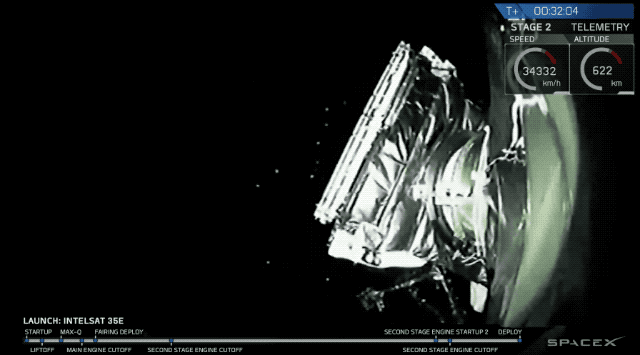
Tech & Sci
12:19, 06-Jul-2017
SpaceX successfully launches Falcon 9 after two delays

A SpaceX Falcon 9 rocket blasted off on Wednesday from the Kennedy Space Center in Cape Canaveral, Florida, carrying a communication satellite for parts of the Caribbean, Europe and Africa.
The takeoff came after twice ditching launch plans in the final seconds before liftoff earlier this week.

The launch on Wednesday went ahead after two delays. /SpaceX Photo
The launch on Wednesday went ahead after two delays. /SpaceX Photo
The launch was initially planned for Sunday but was rescheduled due to some technical issues which triggered automatic cancellation signal by computers.
The Falcon 9 rocket carrying the broadband communication satellite, known as IntelSat 35e, soared into the blue sky over Cape Canaveral at 7:38 p.m. (2338 GMT) and to a distant, geostationary orbit.

The Falcon 9 rocket soars into the evening sky. /SpaceX Photo
The Falcon 9 rocket soars into the evening sky. /SpaceX Photo
The force required to send the payload to space meant SpaceX decided not to attempt to return the first stage booster of its Falcon 9 rocket for an upright landing. Moreover, there will not be enough fuel left to fly the booster back to the Earth.
The California-based company now regularly lands the tall portion of the rocket back on the Earth following launches, as part of its effort to make rocket parts reusable, like airplanes.

SpaceX successfully deployed the Intelsat 35e satellite to its target geostationary transfer orbit. /SpaceX Photo
SpaceX successfully deployed the Intelsat 35e satellite to its target geostationary transfer orbit. /SpaceX Photo
The delay on Sunday was not also due to any flaws with the rocket, SpaceX said. The attempt on Monday also suffered a hold 10 minutes before liftoff.
A SpaceX commentator said on the company's launch webcast that Monday's delay came about when a measurement in the rocket's first stage avionics system did not meet a reprogrammed software limit, but the rocket was in good shape.

Putting on a dramatic show, the Falcon 9's exhaust plume expands in the lower-pressure upper atmosphere as it accelerates toward space after it launched on July 5, 2017. /SpaceX Photo
Putting on a dramatic show, the Falcon 9's exhaust plume expands in the lower-pressure upper atmosphere as it accelerates toward space after it launched on July 5, 2017. /SpaceX Photo
"SpaceX team reviewed all systems again late last night," SpaceX chief executive Elon Musk said on Twitter ahead of the launch. "Done our best to ensure all is good."
The satellite is the fourth of Intelsat's EpicNG next-generation high throughput satellites, and aims to improve wireless connectivity for the Caribbean, Europe and Africa.
(Source: AP, AFP)
12220km
Related stories:

SITEMAP
Copyright © 2018 CGTN. Beijing ICP prepared NO.16065310-3
Copyright © 2018 CGTN. Beijing ICP prepared NO.16065310-3